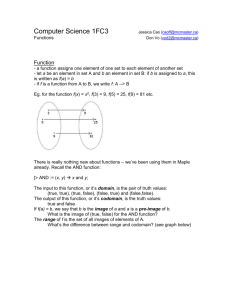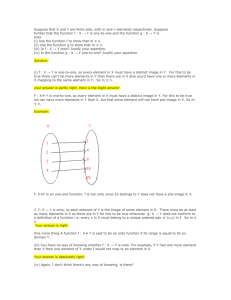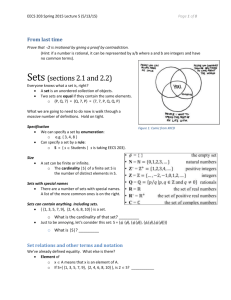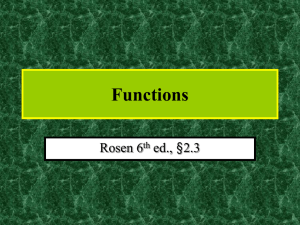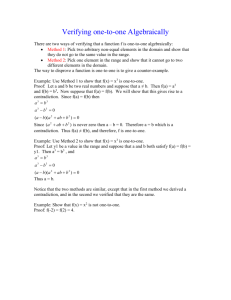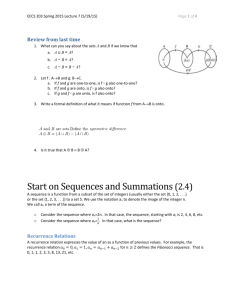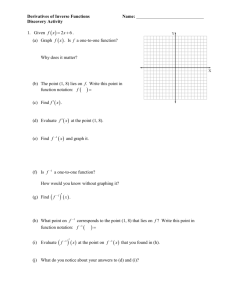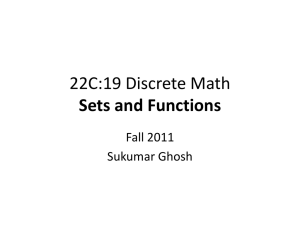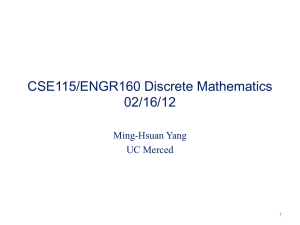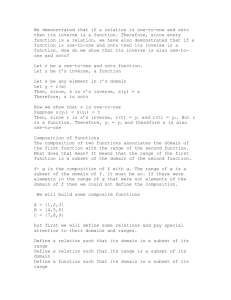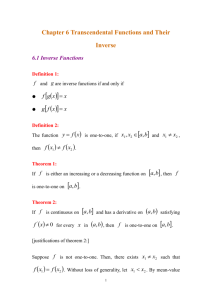docx
advertisement
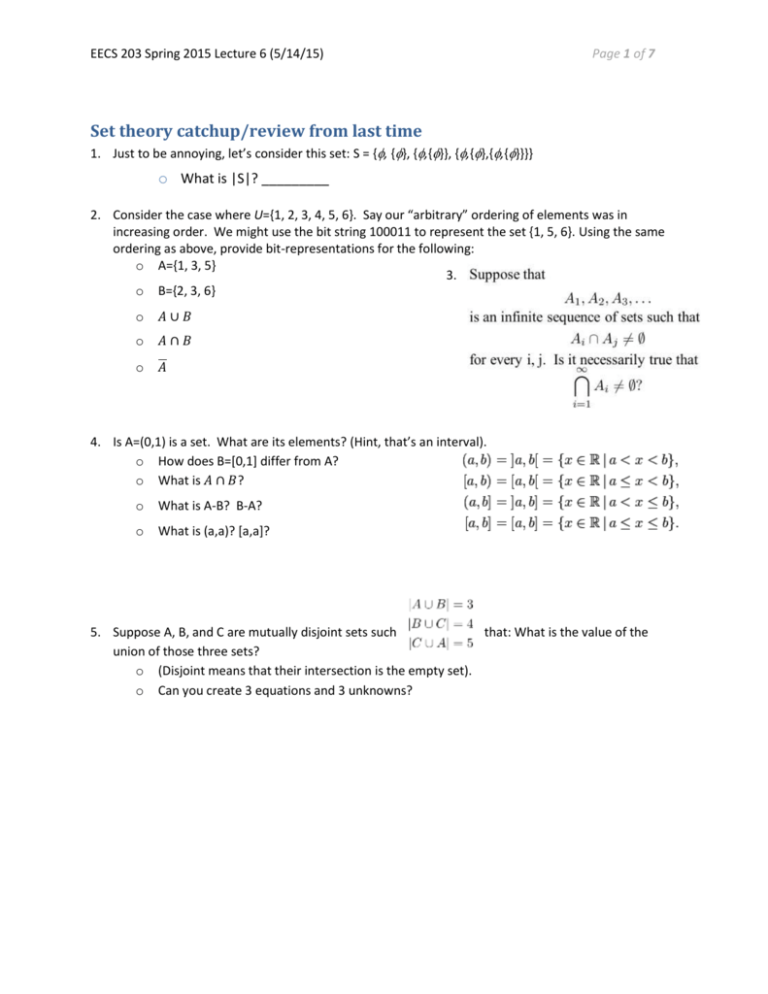
EECS 203 Spring 2015 Lecture 6 (5/14/15)
Page 1 of 7
Set theory catchup/review from last time
1. Just to be annoying, let’s consider this set: S = {, {}, {,{}}, {,{},{,{}}}}
o What is |S|? _________
2. Consider the case where U={1, 2, 3, 4, 5, 6}. Say our “arbitrary” ordering of elements was in
increasing order. We might use the bit string 100011 to represent the set {1, 5, 6}. Using the same
ordering as above, provide bit-representations for the following:
o A={1, 3, 5}
3.
o B={2, 3, 6}
o
𝐴∪𝐵
o
𝐴∩𝐵
o
𝐴
4. Is A=(0,1) is a set. What are its elements? (Hint, that’s an interval).
o How does B=[0,1] differ from A?
o What is 𝐴 ∩ 𝐵?
o
What is A-B? B-A?
o
What is (a,a)? [a,a]?
5. Suppose A, B, and C are mutually disjoint sets such
that: What is the value of the
union of those three sets?
o (Disjoint means that their intersection is the empty set).
o Can you create 3 equations and 3 unknowns?
EECS 203 Spring 2015 Lecture 6 (5/14/15)
Page 2 of 7
Start on Functions (section 2.3)
As has been traditional in this class, we will start by defining a bunch of terms related to functions and
then start using them.
Figure 1: From http://www.mathsisfun.com
In figure 1, we are considering a function f(x)=2x+1 over the domain {1,2,3,4} and mapping to the
codomain {1, 2, 3, 4, 5, 6, 7, 8, 9, 10}. The range, or image, is {3, 5, 7, 9}.
Questions
1. With domain and codomain of R, say we define f such that f(x)=y iff x=y2. Is f a function? Why
or why not? If so, what is its range?
2. With domain and codomain of R, say we define f such that f(x)=1/x2. Is f a function? Why or why
not? If so, what is its range?
3. With domain and codomain of R, say we define f such that f(x)=y iff 𝑦 = ⌈𝑥⌉. Is f a function?
Why or why not? If so, what is its range?
EECS 203 Spring 2015 Lecture 6 (5/14/15)
Page 3 of 7
One-to-one and Onto
Obviously different functions have different
properties. But there are two properties held by
some functions that can be very useful.
o
A function which never assigns the same value
to two different domain elements is called
“one-to-one”.
o
A function which has a range that is equal to its codomain is called “onto”
Below are some examples (from page 144 of the text) illustrating the one-to-one and onto properties.
Questions:
1. Consider the following:
o Let A be the set of UM students and staff.
o Let B be the set of characters strings that form legal UM unique names
o Let 𝑓: 𝐴 → 𝐵 be the assignment of a unique name to a UM person.
Is f a function?
Is f onto?
Is f one-to-one?
2. With domain and codomain of R, say we define f such that f(x)=y iff 𝑦 = ⌈𝑥⌉. Is f one-to-one?
Onto?1
3. With domain and codomain of R, say we define f such that f(x)=x3. Is f one-to-one? Onto?
4. With domain and codomain of R, say we define f such that f(x)=x2. Is f one-to-one? Onto?
1
This is the ceiling function and it is defined to be the next largest integer (basically rounding up).
EECS 203 Spring 2015 Lecture 6 (5/14/15)
Page 4 of 7
Inverse functions
If a function f is both one-to-one and onto then we say that it is a bijection or a one-to-one
correspondence.
In such a case f has a unique inverse f-1 defined by: f-1(b)=a iff f(a)=b.
Questions
Let f be the function from {a, b, c} to {1, 2, 3} such that f (a) = 2, f (b) = 3, and f (c) = 1. Is f
invertible, and if it is, what is its inverse?
Let f : Z → Z be such that f (x) = x + 1. Is f invertible, and if it is, what is its inverse?
Let f be the function from R to R with f (x) = x2. Is f invertible, and if it is, what is its inverse?
Composition of functions
Suppose f: AB and g: BC.
o f(a)=b and g(b)=c for aA, bB, and cC.
Then the composition h = g f is a function h: AC or (g f): AC
o Note: g f is read as “g composed with f”.
o h(a)=_________________________
o
Note that the composition f ◦ g cannot be defined unless
the range of g is a subset of the domain of f
Function Review Questions
1. Let f : AB and g: BC.
a. If f and g are one-to-one, is f ◦ g also one-to-one?
b. If f and g are onto, is f ◦ g also onto?
EECS 203 Spring 2015 Lecture 6 (5/14/15)
c. If g and f ◦ g are onto, is f also onto?
2. Give an example of a function from N to N that is
a. one-to-one but not onto.
b. onto but not one-to-one.
c. both onto and one-to-one (but different from the identity function).
d. neither one-to-one nor onto.
Page 5 of 7
EECS 203 Spring 2015 Lecture 6 (5/14/15)
Page 6 of 7
Start on Sequences and Summations (2.4)
A sequence is a function from a subset of the set of integers (usually either the set {0, 1, 2, . . .}
or the set {1, 2, 3, . . .}) to a set S. We use the notation an to denote the image of the integer n.
We call an a term of the sequence.
o
o
Consider the sequence where an=2n. In that case, the sequence, starting with a1 is 2, 4, 6, 8, etc.
1
Consider the sequence where an=𝑛. In that case, what is the sequence?
Recurrence Relations
A recurrence relation expresses the value of an as a function of previous values. For example, the
recurrence relation 𝑎0 = 0, 𝑎1 = 1, 𝑎𝑛 = 𝑎𝑛−1 + 𝑎𝑛−2 for 𝑛 ≥ 2 defines the Fibonacci sequence. That is
0, 1, 1, 2, 3, 5, 8, 13, 21, etc.
The sequence is the solution to the recurrence relation. Ideally we’d be able to find it in “closed form”
or “closed formula” (that is where we could compute an directly without finding an-1 first).
o
o
Define the even integers (from lowest to highest) as a recurrence relation.
Define the factorial function (n!) as a recurrence relation.
Recurrence relations hold a special place in computer science. It is often the case that we develop
algorithms and then ask ourselves how efficient the algorithm is. And fairly commonly we find ourselves
with algorithms where we split the problem into parts and then re-run the algorithm on the parts
(recursive programs do this…). We will in fact spend a fair bit of time near the end of this term learning
some general techniques for solving recurrence relations (one algorithm turns out to be nearly the same
as solving differential equations).
Summation of a sequence
Sometimes we want to know the sum of a sequence. So the sum of the first N elements (a1+a2+…+aN).
We generally write that as
𝑁
∑ 𝑎𝑖
𝑖=1
Consider the following summation of the sequence ½, ¼, etc.
𝑁
∑
𝑖=1
1
2𝑛
Can you find a closed-form solution to that? What is the value as N approaches infinity?
EECS 203 Spring 2015 Lecture 6 (5/14/15)
Page 7 of 7
Find a closed-form solution for the sum of the
sequence 1, 2, 3, etc.
Questions
1. What is the value of ∑5𝑖=0(−2)𝑖 ?
2. What is the closed form of the sum ∑𝑛𝑘=0 𝑎𝑘+1 − 𝑎𝑘 ? (This is called a “telescoping series”)
3. Find
4. Finding the closed form of this one is rather annoying. We’ll save for your homework
𝑛
∑ 𝑘(𝑘 + 1)
𝑘=0
